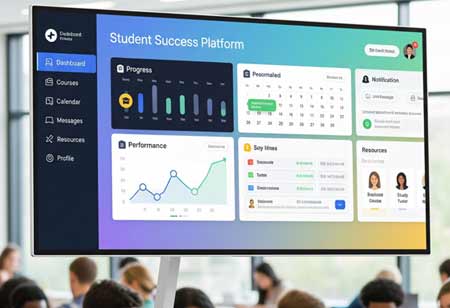THANK YOU FOR SUBSCRIBING
Be first to read the latest tech news, Industry Leader's Insights, and CIO interviews of medium and large enterprises exclusively from Education Technology Insights
Building the Next-Gen Student Support Ecosystem
Educational technology has evolved from basic content delivery to a holistic student success ecosystem, focusing on well-being and personalized support rather than just academic performance.

By
Education Technology Insights | Monday, August 18, 2025
Stay ahead of the industry with exclusive feature stories on the top companies, expert insights and the latest news delivered straight to your inbox. Subscribe today.
Over the past two decades, educational technology has transitioned from a rudimentary content delivery mechanism into a sophisticated, interconnected system that underpins every phase of the student's academic progression. This evolution reflects a profound philosophical transformation within higher education itself: a shift from a singular emphasis on academic achievement to a holistic commitment to student well-being and lasting success. The trajectory from the nascent Learning Management System (LMS) to the contemporary holistic success ecosystem represents a significant paradigm shift in how institutions understand, engage with, and support their students.
The Rise of Data Integration and Early Analytics
The next significant leap forward came with the integration of the LMS with the Student Information System (SIS). Suddenly, the academic data from the LMS could be viewed alongside the rich demographic and administrative data from the SIS, which housed information on enrollment status, financial aid, contact details, and declared majors. This data fusion created the first, albeit rudimentary, 360-degree view of a student.
This newfound connectivity powered the first wave of predictive analytics in student success. By combining data points such as declining grades, poor class attendance, and specific demographic risk factors, institutions can build early-alert systems. These systems represented a significant step forward, enabling advisors and support staff to identify students who were starting to struggle. However, the approach was still fundamentally reactive. An alert was typically triggered after a student had already encountered difficulty, and the subsequent interventions were often standardized rather than personalized. It was a system designed to flag problems, not necessarily to foster strengths or prevent issues before they arose. It connected the dots of student data but hadn't yet learned how to use that picture to change the student's trajectory proactively.
The Dawn of Student Success Platforms
Recognizing the limitations of a reactive model, the industry pivoted towards a more proactive philosophy. This led to the development of the dedicated Student Success Platform (SSP). These platforms were purpose-built not just to identify risk but to coordinate care and streamline support. The focus shifted from "Who is failing?" to "How can we help everyone succeed?"
SSPs introduced a suite of new capabilities. Centralized communication tools created a connected network, linking students directly with their advisors, faculty, tutors, and mentors. Integrated appointment scheduling removed barriers, making it simple for a student to seek help. The early-alert systems became more sophisticated, but more importantly, they were paired with tools for managing and tracking interventions. An advisor can now see a flag for a struggling student, schedule a meeting, document the conversation, create a success plan, and follow up —all within a single interface. This created a longitudinal record of support, enabling a more coordinated and continuous "case management" approach to student advising. The SSP transformed the institutional response from a disconnected set of actions into an orchestrated network of support.
The Holistic Success Ecosystem
Transcending the constraints of a singular platform, this profoundly integrated, philosophy-driven model redefines the essence of "student success." It acknowledges that academic accomplishment is inextricably linked to financial stability, career readiness, and personal well-being, thereby offering a holistic approach to student development.
At its core, the ecosystem rests on four interconnected pillars. Academic success remains foundational, enhanced by intelligent degree-planning tools, progress tracking toward graduation, and AI-driven course recommendations that keep students on the most efficient path. Financial wellness addresses one of the most significant barriers to persistence by integrating support for financial aid, scholarship applications, budgeting, and access to emergency funding. Career readiness is embedded from day one, linking academic pathways to professional outcomes through internships, skills workshops, mentorships, and alumni connections—ensuring graduates leave with both a degree and a career plan. Belonging and Well-being reflect the most profound shift: prioritizing the whole student. By fostering connections to campus communities, tracking engagement data to identify potential instances of isolation, and providing discreet access to mental health resources, the ecosystem promotes a strong sense of inclusion and personal resilience.
This model is powered by next-generation technology, where AI and machine learning have evolved from predictive analytics to prescriptive solutions—not merely identifying challenges but recommending targeted, personalized interventions. Drawing from every touchpoint of the student experience, these systems create a 360-degree profile that is increasingly student-facing. Through personalized dashboards and self-service tools, students are empowered to navigate and shape their own academic and personal journeys actively, making the Holistic Success Ecosystem a transformative force in higher education.
This technological evolution signifies a monumental shift from an institution-centric to a student-centric model. The old LMS asked, "Here is the information you need." The new ecosystem asks, "Who are you, what are your goals, and how can we orchestrate all our resources to help you grow?" The journey from a simple digital repository to a holistic support ecosystem is more than an upgrade in technology; it is the maturation of an institutional promise to educate not only students but also to ensure they flourish.







